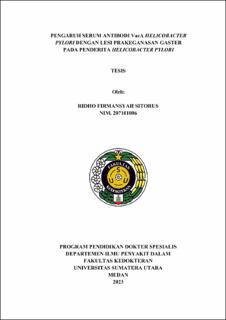Pengaruh Serum Antibodi VacA Helicobacter Pylori dengan Lesi Prakeganasan Gaster pada Penderita Helicobacter Pylori
Correlation Between Helicobacter Pylori VacA Antibody Serum and Gastric Premalignant Lesions in Helicobacter Pylori Patients

Date
2023Author
Sitorus, Ridho Firmansyah
Advisor(s)
Ilhamd
Sungkar, Taufik
Metadata
Show full item recordAbstract
Background : Gastric cancer is the 5th most common malignancy in the world based on data
from GLOBOCAN 2018. H. pylori has virulence factors involved in this process, strains that
harbor variants of vacuolating cytotoxin gene A (vacA) and cytotoxin associated gene A (cagA)
which are can induce an increased inflammatory response in infected cells that can change the
gastric mucosa until gastric malignancy occurs. Early detection can be done by using CagA and
VacA antibody tests on H.pylori
Aim : To determine the relationship between serum VacA antibody to premalignant lesions in
H.pylori patients
Method : This study was an analytical study with a cross-sectional design to assess the
relationship between serum VacA H. pylori antibodies and premalignant gastric lesions in H.
pylori patients conducted at Adam Malik General Hospital, Medan. The minimum number of
samples required is 28. The study was carried out by performing endoscopy to view the gastric
mucosa and taking tissue for histopathology. Biopsy was performed at 5 sites (A1, A2, A3, C1,
and C2). Histopathological examination was carried out at the Department of Anatomical
Pathology, Faculty of Medicine, University of North Sumatra to see any premalignant gastric
lesions. Then the VacA antibody serum was examined by ELISA and the data was analyzed
statistically
Result : The number of samples obtained was 60 with an average sample age of 49 years. 45
samples (75%) showed positive VacA antibody results and 21 (35%) samples showed
histopathological results of premalignant gastric lesions. Statistical test results showed no
association between VacA antibody and gastric premalignant lesions (p = 0.639).
Conclusion : There is no association between VacA antibody and gastric premalignant lesions.
More in-depth research is needed, especially regarding the strain region present in VacA and its
use in evaluating therapy or determining the prognosis
Collections
- Master Theses [407]
